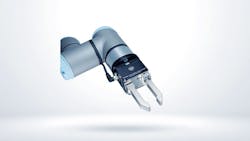Universal Robots' New e-Series Unveiled, and Researched at Autodesk
Universal Robots has introduced a new flagship line, known as the e-Series cobots, to its family of collaborative robots. The new UR3e, UR5e and UR10e robot arms feature a new built-in, tool-centric force/torque sensor for use in applications such as sanding, buffing, polishing and deburring where force-feedback is required to obtain uniform results. This new force/torque sensor can also be used to measure mass and perform inspection processes or precisely detect contact.
The e-Series features an increased repeatability of 30 microns (0.03mm) in the UR3e and UR5e models and 50 microns (0.05mm) in the UR10e, which makes them suitable for precise finishing, assembly and electronics tasks, according to Universal Robots.
The company further claims the e-Series new wrist-joint-tool communication interface “reduces production line integration time and the hassle associated with routing cables between the end-effector and control cabinet. All joints are field replaceable in under six minutes.”
Another new aspect of the e-Series is a responsive touch user interface that Universal Robots says expedites program development by reducing programming to a few clicks. The interface also permits access to an external 500Hz system bus for more complex motion-control algorithms or profiles, such as advanced machine vision applications, and has the ability to program stopping time and stopping distance for protective stops. This unique stopping time feature is not found on any other collaborative robot, according to the company, and greatly reduces the complexity and uncertainty involved in performing pre-deployment risk assessments. The robot series’ seventeen safety functions are certified by TÜV Nord and comply with the latest ISO machinery safety standards for unobstructed human-robot collaboration.
The tool power supply for e-Series platform supports up to 2A of peak current and adds four additional digital inputs with an associated interface for use with conveyor tracking.
In related news, Autodesk—a supplier of design software for the manufacturing, architecture, building/construction and media/entertainment industries—selected Universal Robots' new series for use in a variety of research projects. Though many of Autodesk's projects focus on the construction industry, one is aimed at developing a smart assembly system that could have use in the manufacturing industries.
Autodesk is using machine learning with Universal Robots' e-Series to explore the potential of smart robotic assembly systems, said Yotto Koga, software architect in Autodesk’s Robotics Lab. “Today, assembly systems tend to be hard-coded, which means that when parts become misaligned or need to be swapped out, the design of the assembly process needs to be changed. So, with this project, we’re trying to create a more robust assembly system—something that’s smart, flexible to change and easy to set up so our customers can take their design and have a system automatically put it together,” he added.
The smart assembly system project at Autodesk uses Universal Robots cobots to address three specific assembly issues: bin-picking, re-grasping and placement.
“We’re starting with Lego blocks right now in assemblies with very tight tolerances. Since Lego has some 10,000 different size bricks available, we can develop some pretty complex assembly scenarios,” said Koga
In Autodesk's project, a UR10e robot picks a pre-defined brick from a jumble of bricks of different sizes and colors. If the brick is grasped in the wrong position for placement, the UR10e performs a visual survey and can re-position and re-grasp the brick until it is correctly placed in the gripper. The final placement is also vision-guided by a second robot, a UR5e, holding a camera to check the brick assembly.
“One of the major reasons we chose Universal Robots is because they are safe to work around,” said Koga. “I can literally connect the robot to my laptop, work next to it, and quickly iterate through our experiments without worrying about safety protocols slowing things down. This was very important for us to make progress in this project.”

